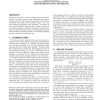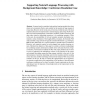257 search results - page 4 / 52 » An interval logic for natural language semantics |
WOLLIC
2007
Springer
13 years 12 months ago
2007
Springer
In this paper, we explore the Lambek-Grishin calculus LG: a symmetric version of categorial grammar based on the generalizations of Lambek calculus studied in Grishin [1]. The voca...
FOAL
2007
ACM
13 years 9 months ago
2007
ACM
Nonmonotonic logic is a branch of logic that has been developed to model situations with incomplete information. We argue that there is a connection between AOP and nonmonotonic l...
SEMWEB
2010
Springer
13 years 3 months ago
2010
Springer
Systems based on statistical and machine learning methods have been shown to be extremely effective and scalable for the analysis of large amount of textual data. However, in the r...
ENTCS
2002
13 years 5 months ago
2002
In this work we provide a semantic description of functional logic languages covering notions like laziness, sharing, and non-determinism. Such a semantic description is essential...
VL
2007
IEEE
14 years 19 hour ago
2007
IEEE
Interval-valued computation is an unconventional computing paradigm. It is an idealization of classical 16-, 32-, 64- etc. bit based computations. It represents data as specific ...


